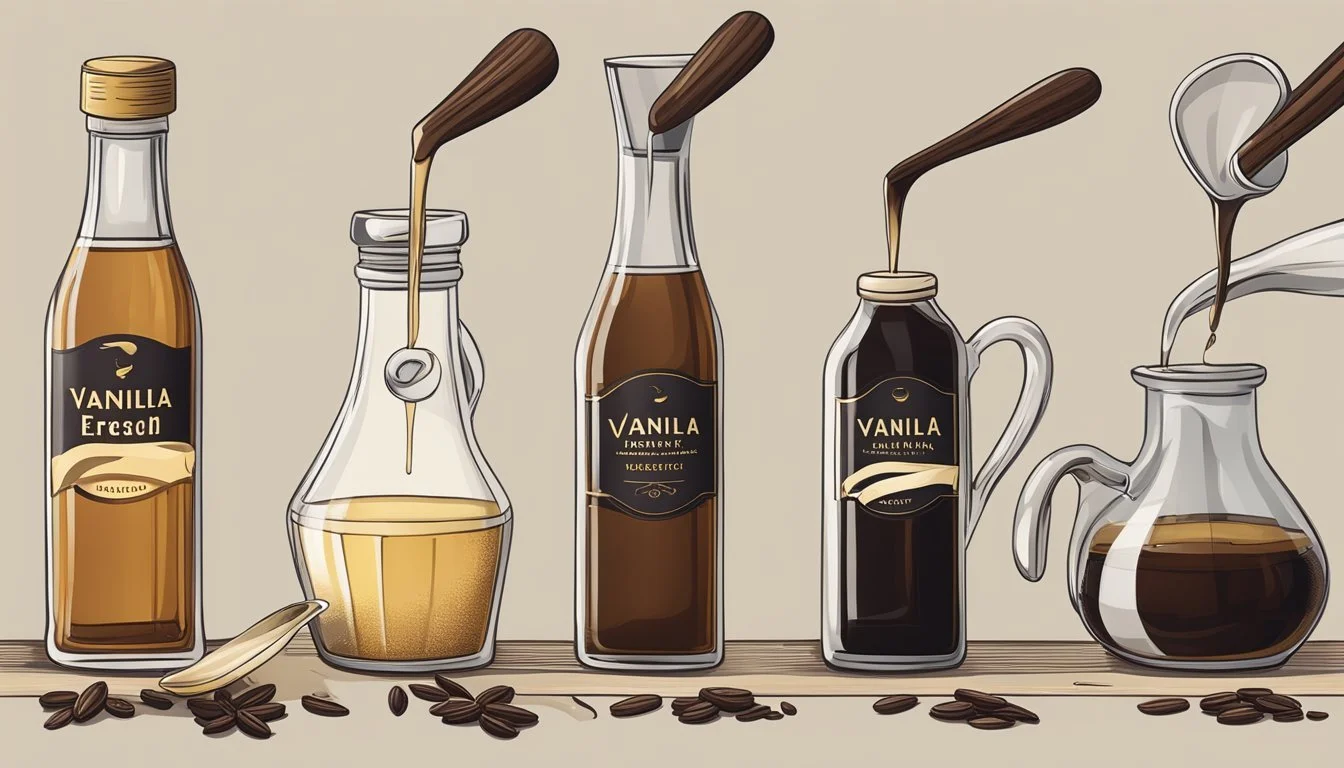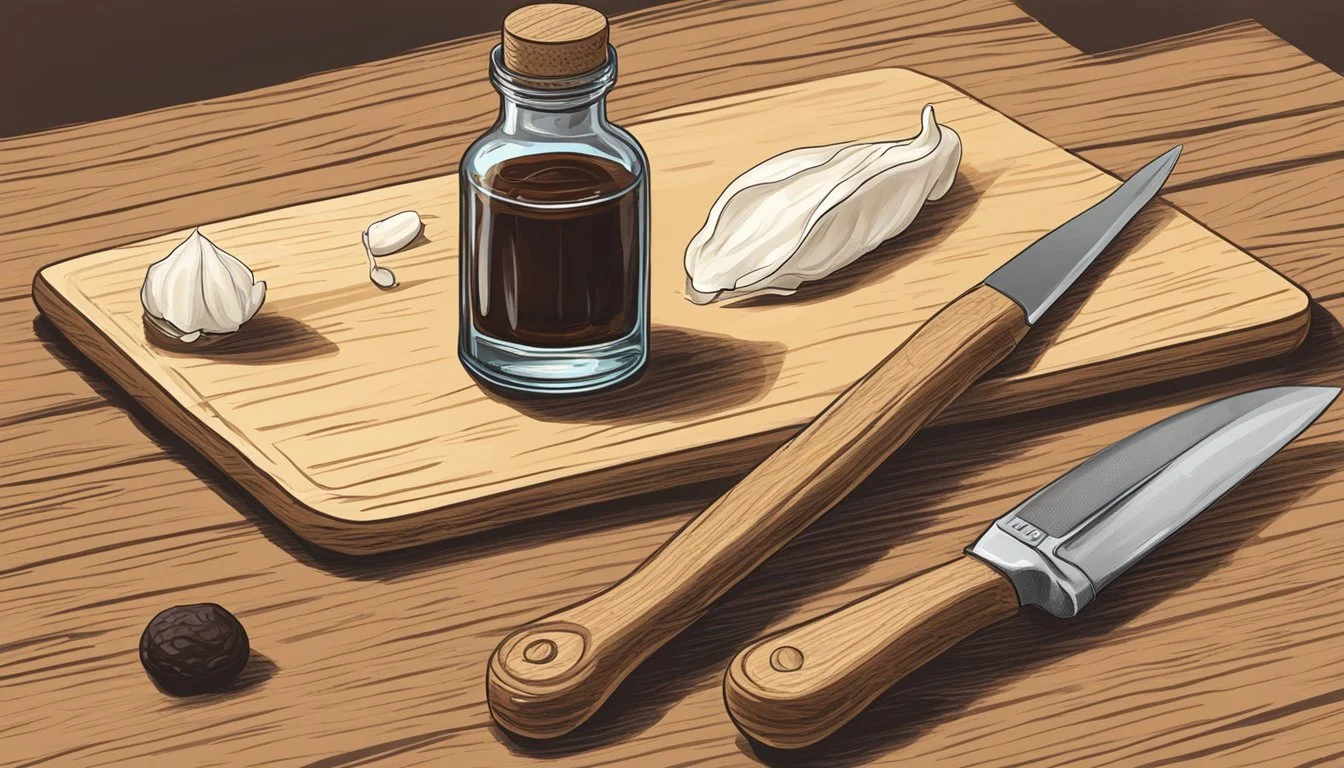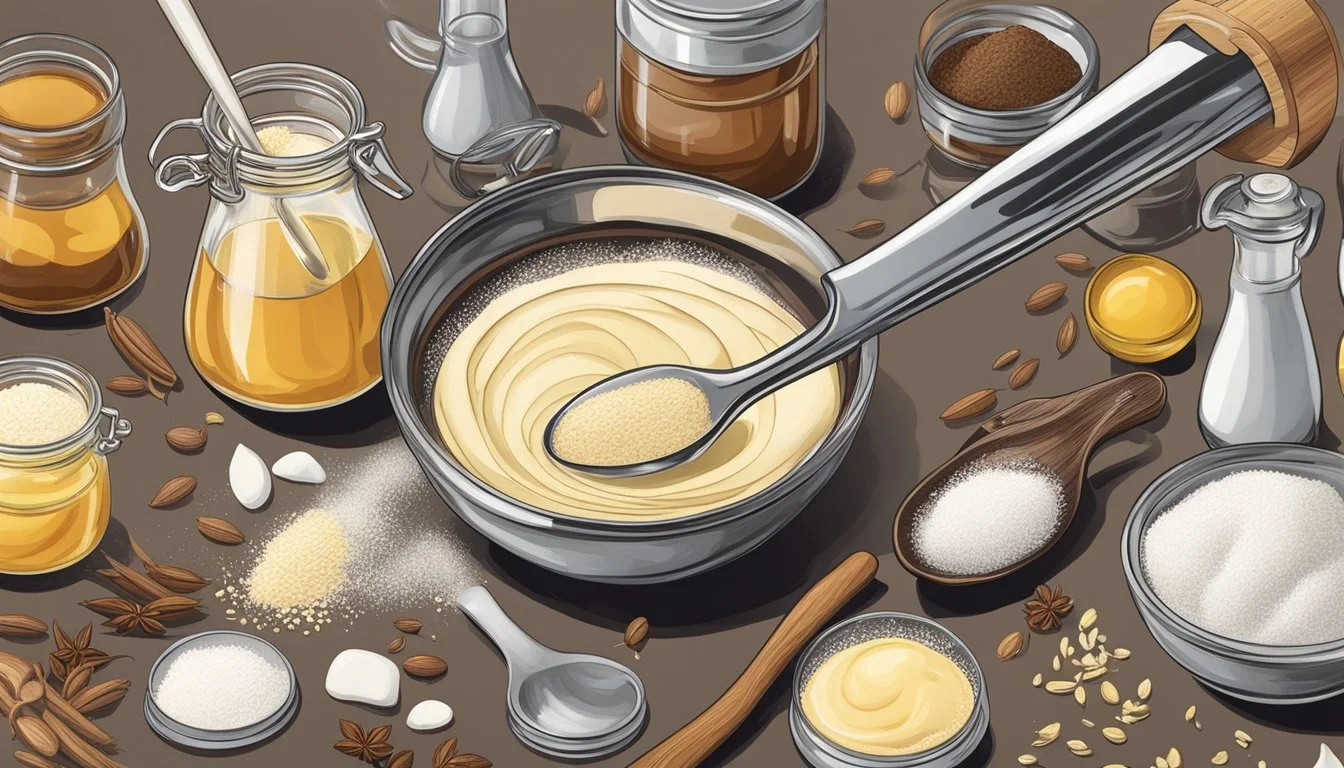How to Substitute Vanilla Extract for Vanilla Bean
A Simple Guide
Vanilla extract and vanilla beans are essential flavors in the culinary world, often used to enhance a wide array of dishes. Vanilla extract, a solution made by macerating and percolating vanilla beans in a mixture of alcohol and water, is a convenient and commonly available form of vanilla. It is a staple in many kitchens for its ability to infuse recipes with vanilla's warm and rich nuances without the need to handle whole beans.
Substituting vanilla extract for vanilla beans is a simple process. While there is a general guideline to follow when making this substitution, the specific amount may vary based on personal preference and the intensity of the vanilla flavor desired. Typically, one tablespoon of vanilla extract is equivalent to one vanilla bean, which offers a practical and cost-effective alternative for recipes calling for the whole pod.
When using vanilla extract as a substitute, it's important to consider the quality and type of the extract. Pure vanilla extract is preferred over imitation versions, as it provides a more authentic and complex vanilla flavor derived from real vanilla beans. Extracts maintain the essence of vanilla and can be used without worrying about the added volume of liquid affecting most recipes, a consideration that is especially pertinent in delicate culinary applications like candy making.
Understanding Vanilla Flavor
The complexity of vanilla flavor is derived from its botanical source and the method of extracting its essence. Each form of vanilla, be it a bean or an extract, contributes a distinct characteristic to culinary creations.
Vanilla Extract and Its Ingredients
Vanilla extract is a solution made primarily from vanilla beans that have been soaked in alcohol and water. This process extracts the flavor components from the beans into the liquid. The ingredients of vanilla extract typically include:
Vanilla beans: The pods harvested from the vanilla orchid plant.
Alcohol: Acts as a solvent to dissolve the flavor compounds.
Water: Dilutes the alcohol and helps in the extraction process.
The concentration of these ingredients in the extract determines the strength of the vanilla flavor and aroma.
Properties of Vanilla Beans
Vanilla beans, the fruit of the vanilla orchid, are valued for their rich flavor and aromatic qualities. The properties of vanilla beans include:
Flavor profile: A complex blend of over 250 flavor compounds, with vanillin being the most prominent.
Aroma: Warm, creamy, and mellow scent that is both comforting and stimulating.
Vanilla seeds: Tiny seeds found inside the beans are often used in recipes to add visual appeal and concentrated flavor.
By understanding these qualities, one can better utilize vanilla extract and beans to enhance the flavor of various dishes.
Substitution Basics
When cooking or baking, one may need to use vanilla extract as a substitute for vanilla bean. This section will help the reader understand the correct conversion ratios and important considerations to ensure the substitute maintains the intended flavor and quality of the recipe.
The Conversion Ratio
One vanilla bean corresponds to approximately 1 tablespoon of vanilla extract. This ratio can be a starting point for substitution:
1 inch of vanilla bean = 1 to 2 teaspoons of vanilla extract
1 whole vanilla bean = 1 tablespoon of vanilla extract
These guidelines assure that the essence of vanilla is appropriately captured in the dish or dessert.
Considerations for Baking and Cooking
When substituting vanilla extract for vanilla bean in baking or cooking, one must consider the following:
Flavor intensity: Extracts can have a more concentrated flavor. Adjust according to taste preferences, whether milder or more intense.
Consistency and volume: Liquid extract may slightly alter the consistency of a recipe compared to the fibrous texture of a scraped vanilla bean pod.
Ingredients interaction: Vanilla extract might interact differently with other ingredients due to its alcohol base.
Heat stability: Vanilla extract can lose some flavor when subjected to high heat, so it may be best added at the end of cooking.
By adhering to these considerations, one ensures the substitution maintains the flavoring and consistency vital for the success of a recipe.
Alternative Vanilla Flavors
When substituting vanilla extract for vanilla beans, one has numerous flavorful alternatives to consider. These substitutes can closely mimic the original flavor profile of vanilla beans or provide a unique twist to recipes.
Vanilla Bean Paste
Vanilla bean paste is a thick, syrup-like preparation that contains a blend of concentrated vanilla extract and small bits of vanilla bean seeds. The paste is potent and emits a flavor akin to that of a vanilla bean. Typically, one tablespoon of vanilla bean paste equates to one whole vanilla bean.
Vanilla Powder and Vanilla Sugar
Vanilla powder consists of dried and powdered vanilla beans and often includes a small amount of sugar to prevent clumping. Vanilla sugar is made by infusing granulated sugar with vanilla beans over time. Both offer a subtle vanilla flavor and can be used in equal measure to the amount of vanilla bean called for, without adding additional moisture to recipes.
Imitation Vanilla and Extracts
Imitation vanilla, often labeled as vanilla flavoring, is a synthetic product that mimics the vanilla taste using artificial compounds. These are less expensive alternatives to real vanilla extract, offering a similar flavor profile at a lower cost. They are typically used in a one-to-one ratio when replacing vanilla bean in recipes.
Using Other Flavorings as Substitutes
Almond extract and other flavored extracts can be used in place of vanilla to give a different, yet complementary, flavor profile. These extracts are strong and should be used sparingly; often, half a teaspoon of almond extract can replace a whole vanilla bean. These substitutes work well when one desires a nuanced flavor that diverges from the classic vanilla taste.
Culinary Applications
Substituting vanilla extract for vanilla bean is a common technique in cooking and baking due to the scarcity and expense of vanilla beans. The correct substitution ratio and method can significantly alter the outcome in desserts, beverages, and even savory dishes.
Incorporating in Desserts
In dessert recipes like cakes, cookies, and other baked goods, one can substitute vanilla extract for vanilla beans. A general guideline is that 1 tablespoon of vanilla extract is equivalent to 1 vanilla bean. For enriched flavors in custards (how long do custards last?) or ice cream, where vanilla is the star, one might opt for up to 2 tablespoons to replace the depth of flavor that a whole bean imparts. In a pudding or similar dessert, a 1-to-1-inch substitution—1 teaspoon of extract per inch of vanilla bean—is often sufficient.
Cakes and Baked Goods: Use 1 tablespoon of extract for one vanilla bean.
Cookies: Substitute with 1 teaspoon per inch of bean.
Custards and Ice Cream: Consider using 2 tablespoons of extract to replicate the vanilla bean's prominent flavor.
Adjusting Vanilla Flavors in Beverages
When flavoring beverages such as coffee or vanilla-flavored milk, the substitution is straightforward: use a small amount, about 1 teaspoon of vanilla extract, to replace each inch of the vanilla bean. As beverages generally only require a hint of vanilla, this ratio will impart the desired vanilla essence without overwhelming the drink. For example:
Coffee: Start with 1/2 teaspoon of vanilla extract and adjust to taste.
Vanilla-flavored Milk: Mix in 1 teaspoon of extract for each pint of milk.
Savory Dishes and Seasonings
Vanilla extract is less commonly used in savory dishes, but it can add a unique flavor profile to certain recipes, such as salad dressings or sauces. When substituting vanilla extract for vanilla bean, use the extract sparingly to avoid overpowering the savory flavors. Only a small amount, perhaps 1/2 teaspoon, is generally enough to achieve the subtle vanilla undertone.
Salad Dressing: A few drops of vanilla extract can sweeten and add a unique twist.
Savory Seasonings: Start with 1/2 teaspoon and adjust according to the recipe size and the intended flavor strength.
Advanced Vanilla Techniques
Mastering the art of substituting vanilla extract for vanilla beans involves understanding key culinary techniques. This section delves into infusing liquids with the essence of vanilla, utilizing every part of the vanilla bean, and crafting homemade vanilla extract to enhance the flavor in your recipes.
Infusing Vanilla into Liquids
To infuse a liquid with vanilla, one can steep whole vanilla beans or scrapings from the beans in the liquid of choice. Typically, the pod is split lengthwise to expose the seeds, allowing the distinctive vanilla flavor to permeate the liquid. For instance, when making a custard or ice cream base, infuse the milk or cream by heating it with the vanilla pod and seeds over low heat; this should not boil, to prevent altering the delicate vanilla flavor.
Extracting Seeds and Pod Uses
The magic of vanilla is concentrated within the tiny seeds inside the pod. To extract them, split the bean with a sharp knife and scrape the seeds out:
Splitting: Carefully run a knife down the length of the bean, opening it up.
Scraping: Use the back of the knife to scrape along the inside of the bean to collect the seeds.
The remaining pod shouldn't be discarded, as it still holds plenty of flavor. It can be submerged into a jar of sugar to create vanilla-infused sugar, or added to syrups or liquors for a subtle vanilla note.
Homemade Vanilla Extract Crafting
Creating homemade vanilla extract requires two primary ingredients: vanilla beans and alcohol. Use the following steps to craft your extract:
Split the beans: Cut each vanilla bean lengthwise to expose the seeds.
Submerge beans in alcohol: Place the split beans in a jar and cover with a high-proof alcohol, like vodka or bourbon.
Steep: Allow the beans to steep in the alcohol for at least 8 weeks. The longer they steep, the stronger the extract.
Strain: Use a fine-mesh strainer to remove any solids before bottling your extract.
Opt for high-quality, whole vanilla beans to achieve the best flavor profile in your homemade extract. Over time, these techniques can expand one's culinary skills, offering the ability to substitute pure vanilla extract in recipes that call for vanilla beans.
Pairing with Other Ingredients
When substituting vanilla extract for vanilla bean, the success in flavor pairing with other ingredients can transform a recipe. Vanilla extract can work harmoniously with various sugars and sweeteners, meld with the right spices and herbs, and can be accentuated by select alcoholic additions.
Synergy with Sugars and Sweeteners
Vanilla extract has a natural affinity with sugar, enhancing its sweetness and providing a rich depth. When combined with pure maple syrup in baked goods such as brownies or as a topping, it imparts a warm, complex sweetness. Honey can also be paired with vanilla extract to create a smooth and subtly floral flavor, especially in vanilla buttercream frosting where the extract highlights the honey's natural tones.
Complementary Spices and Herbs
Vanilla extract bolsters the aromatic qualities of many spices such as cinnamon, cardamom, and nutmeg, each of which complements the extract's warm notes in dessert recipes. Certain herbs, like mint, can be enlivened by vanilla's sweet undertones, adding an extra layer of flavor without overpowering the main ingredient. When these spices and herbs are paired correctly, they produce a symphony of flavors that enhance the overall taste of the dish.
Alcoholic Enhancements
The presence of vanilla extract can be boosted by the addition of alcohol, particularly those with inherent vanilla notes. Brandy, with its fruity and somewhat sweet taste, pairs beautifully with vanilla extract in baked desserts. Rum with its sugar cane base, accentuates vanilla's sweetness, making it an excellent choice for both flavoring and soaking baked goods. Meanwhile, bourbon offers a smoky, caramel-like undertone that synergizes with the rich flavors of vanilla, especially in recipes for vanilla buttercream frosting.
Vanilla Sourcing and Varieties
In the realm of baking and culinary arts, vanilla is revered for its ability to enhance flavors with its sweet and complex notes. The source and variety of vanilla play pivotal roles in determining the bean's flavor profile and consistency.
Madagascar: The Classic Source
Madagascar, renowned for producing Bourbon vanilla, is hailed as the classic source of high-quality vanilla beans. These beans are esteemed for their rich and creamy flavors, boasting a traditional vanilla taste that is often described as full-bodied. Madagascar vanilla beans are typically plump and moist, making them ideal for recipes where the vanilla's presence is meant to be front and center.
Flavor Profile: Rich, Creamy, Full-bodied
Common Use: Ideal for ice creams, custards, and classic baked goods
Tahitian and Mexican Vanilla
Tahitian vanilla, sourced from the orchids found in Tahiti, is known for its floral and fruity overtones. These beans are less dense than their Madagascar counterparts, with a more delicate flavor profile that works well in lighter desserts and fruit-based preparations.
Mexican vanilla, originating from Mexico, carries a flavor that is described as spicy and woody. Mexican vanilla beans are historically significant as Mexico is the birthplace of vanilla. The beans tend to be thin and less oily, yet they encapsulate a unique warmth and depth of flavor.
Tahitian Flavor Profile: Floral, Fruity, Delicate
Mexican Flavor Profile: Spicy, Woody, Deep
Criteria for Selecting Quality Vanilla
When selecting whole vanilla beans, certain criteria should guide the decision to ensure quality. Beans should be:
Plump: Indicative of moisture content and essential oils.
Flexible: A sign of freshness, as dry beans may be older and less potent.
Fragrant: A strong, pleasant aroma suggests high-quality beans.
It's essential to slice the bean open to extract the maximum flavor, and each bean's sourced region influences the consistency and notes of the dishes it enriches.
Practical Tips and Tricks
When substituting vanilla extract for vanilla beans, it's important to consider the storage of vanilla, heed advice from renowned chefs like Ina Garten, and recognize the visual cues that indicate quality vanilla. This ensures the best possible flavor for your culinary creations.
Proper Vanilla Storage
Vanilla extract should be stored in a cool, dark place to maintain its potency. Ideally, one should keep it tightly sealed in a glass bottle to prevent the flavor from deteriorating over time. Exposure to heat and light can cause vanilla extract to lose its rich flavor, so one should avoid storing it above the stove or under direct sunlight.
Ina Garten's Vanilla Advice
Ina Garten recommends using good quality vanilla for better flavor. She often suggests using pure vanilla extract rather than imitation vanilla flavor, as it gives a depth of flavor that imitation cannot match. The acclaimed chef also advises that if one is using vanilla extract as a substitute for vanilla beans, they should consider the concentration of vanilla in pure extract compared to that found in natural beans. For every one vanilla bean, two to three teaspoons of pure vanilla extract can be used as a substitute.
Visual Cues of Quality Vanilla
To determine the quality of a vanilla bean, one should look for plumpness and a glossy exterior, which indicates that it's moist and flavorful. In the case of pure vanilla extract, one can assume quality if there are small black specks present; these specks are the seeds from the vanilla pod and are often found in higher-grade extracts. When seeking a substitute for vanilla beans, one should choose an extract that exhibits these qualities to ensure a close match in flavor.






